Module 18 - Radar PrinciplesPages
i,
1-1, 1-11,
1-21,
1-31,
1-41,
2-1,
2-11,
2-21,
2-31,
2-41,
3-1,
3-11,
3-21,
4-1,
4-11,
4-21,
AI-1,
AII-1,
Index-1 to 3
Chapter 3
Radar INDICATORS and Antennas Learning Objectives Upon completion of this chapter, the student will be able to: 1. Describe the purpose of the a scope,
the range-height indicator (rhi), and the plan position indicator (PPI). 2. State the relationship
between range and sweep speed and length on a radar indicator. 3. Explain the purpose of timing triggers,
video, and antenna position inputs to a radar indicator. 4. List the major units of a PPI and describe
their functions.
5. Describe the basic operation of sweep deflection and sweep rotation in a PPI. 6. List and
describe the operation of the three range measurement circuits. 7. Describe antenna directivity and power
gain characteristics.
8. Describe the focusing action of a basic parabolic antenna. 9. Describe the basic radiation
patterns of the most common parabolic reflectors. 10. Describe the basic characteristics of horn
radiators.
Introduction Radar systems require an antenna to both transmit and receive radar energy and an indicator system to display
the video information generated. This chapter will briefly describe some commonly used indicators and antenna
systems. Antenna systems are described in more detail in NEETS, Module 10, Introduction to Wave Generation,
Transmission Lines, and Antennas, and Module 11, Microwave Principles. Radar INDICATORS The information available from a radar receiver may contain as many as several million separate data bits per
second. From these and other data, such as the orientation of the antenna, the indicator should present to the
observer a continuous, easily understandable, graphic picture of the relative position of radar targets. It should
provide size, shape, and insofar as possible, indications of the type of targets. a cathode-ray tube (CRT)
fulfills these requirements to an astonishing degree. The cathode-ray tube's principal shortcoming is that it
cannot present a true three-dimensional picture. The fundamental geometrical quantities involved in radar
displays are the RANGE, AZIMUTH ANGLE (or BEARING), and ELEVATION ANGLE. These displays relate the position of a
radar target 3-1
to the origin at the antenna. Most radar displays include one or two of these quantities as
coordinates of the CRT face. The actual range of a target from the radar, whether on the ground, in the
water, or in the air is known as SLANT RANGE. The majority of displays use as one coordinate the value of slant
range, its horizontal projection (Ground RANGE), or its vertical projection (ALTITUDE). Since slant range is
involved in every radar situation, it inevitably appears in at least one display on every set. Slant range is the
coordinate that is duplicated most often when more than one type of display is used. This is partly because
displays presenting range have the highest signal-to-noise discrimination and partly for geometrical reasons. Range is displayed by means of a linear time-base sweep, starting from a given point or line at a definite time in
each pulse cycle. Thus, distances along this range sweep actually measure slant range. The sweep speed determines
the scale factor, which relates the distance on the tube to actual range. The sweep length is the total distance
represented. Distances are expressed in miles (statute or nautical) or yards. The origin of the range sweep may be
on or off the tube face. The angle at which the antenna is pointing, either in azimuth or elevation, may
provide two- dimensional information in the display; that is, range and azimuth, or range and elevation. A
radar indicator, sometimes called a radar repeater, acts as the master timing device in analyzing the return of
the video in a radar system. It also provides that capability to various other locations physically remote from
the radar system. Each indicator should have the ability to select the outputs from any desired radar system
aboard the ship. This is usually accomplished by the use of a Radar DIsTRIBUTION SwitchBOARD. The switchboard
contains a switching arrangement that has inputs from each radar system aboard ship and provides outputs to each
repeater. The radar desired is selected by means of a selector switch on the repeater. For the repeater to present
correct target position data, the indicator must have the following three inputs from the selected radar: 1. Trigger timing pulses. These pulses ensure that the sweep on the repeater starts from its point of origin each
time the radar transmits. As discussed earlier, the repeater displays all targets at their actual range from the
ship based on the time lapse between the instant of transmission and the instant the target's echo is received. 2. The returning echo. The echo, in RF form, is detected (converted to a video signal) by the radar receiver
and applied to the repeater. 3. Antenna information. The angular sweep position of a plan position
indicator (PPI) repeater must be synchronized to the angular position of the radar antenna to display target
bearing (azimuth) information. The three most common types of displays, called scopes, are the A-scope,
the RANGE-HEIGHT INDICATOR (RHI) SCOPE, and the PLAN POSITION INDICATOR (PPI) SCOPE. The primary function of these
displays will be discussed in this section. However, detailed descriptions will be limited to the PPI scope, which
is the most common display. The a SCOPE The A-scope display, shown in figure 3-1,
presents only the range to the target and the relative strength of the echo. Such a display is normally used in
weapons control radar systems. The bearing and elevation angles are presented as dial or digital readouts that
correspond to the actual physical position of the antenna. 3-2
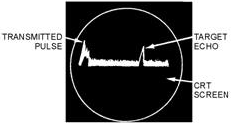
Figure 3-1. - a scope. The A-scope normally uses an electrostatic-deflection CRT. The sweep is produced by applying a sawtooth
voltage to the horizontal deflection plates. The electrical length (time duration) of the sawtooth voltage
determines the total amount of range displayed on the CRT face. The ranges of individual targets on an A-scope
are usually determined by using a movable range gate or step that is superimposed on the sweep. Ranging circuits
will be discussed in more detail later in this section. RANGE-HEIGHT INDICATOR (RHI) The range-height indicator (rhi) scope, shown in figure 3-2, is used with height-finding search radars to
obtain altitude information. The rhi is a two-dimensional presentation indicating target range and altitude. The
sweep originates in the lower left side of the scope. It moves across the scope, to the right, at an angle that is
the same as the angle of transmission of the height-finding radar. The line of sight to the horizon is indicated
by the bottom horizontal line. The area directly overhead is straight up the left side of the scope. Target echoes
are displayed on the scope as vertical PIPS or BLIPS (spots of increased intensity that indicate a target
location). The operator determines altitude by adjusting a movable height line to the point where it bisects the
center of the blip. Target height is then read directly from an altitude dial or digital readout. Vertical range
markers are also provided to estimate target range. 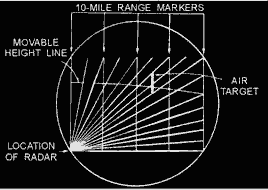
Figure 3-2. - RHI scope. 3-3
Q1. What are the three fundamental quantities involved in radar displays? Q2. What are the
required radar inputs for proper indicator operation? Q3. What coordinates are displayed on an rhi
scope? PLAN POSITION INDICATOR (PPI). The PPI scope shown in figure 3-3, is by far
the most used radar display. It is a polar coordinate display of the area surrounding the radar platform. Own ship
is represented as the origin of the sweep, which is normally located in the center of the scope, but may be offset
from the center on some sets. The PPI uses a radial sweep pivoting about the center of the presentation. This
results in a map-like picture of the area covered by the radar beam. a long-persistence screen is used so that the
display remains visible until the sweep passes again. 3-4
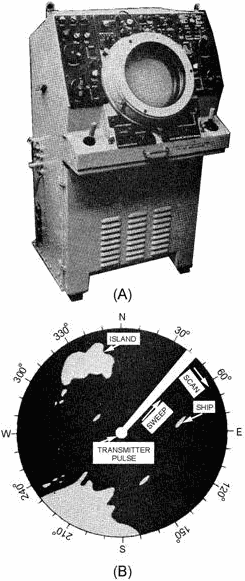
Figure 3-3. - PPI scope. 3-5
Bearing to the target is indicated by the target's angular position in relation to an imaginary line
extending vertically from the sweep origin to the top of the scope. The top of the scope is either true north
(when the indicator is operated in the true bearing mode) or ship's heading (when the indicator is operated in the
relative bearing mode).
PPI Block Diagram The basic block diagram, figure 3-4, illustrates the major units of
a plan position indicator. Synchronization of events is particularly important in the presentation system. At the
instant a radar transmitter fires (or at some predetermined time thereafter), circuits which control the
presentation on the indicator must be activated. These events must be performed to a high degree of accuracy to
ensure accurate range determination. The synchronization of these events is provided by the gate circuit.
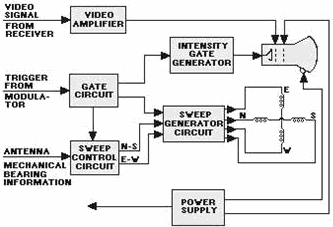
Figure 3-4. - Basic PPI block diagram. GATE Circuit. - The gate circuit develops pulses which synchronize the indicator with the
transmitter. The gate circuit itself is synchronized by trigger pulses from the synchronizer. It then provides
timing for the intensity gate generator, sweep generator circuit, and the sweep control circuit.
SWEEP CONTROL Circuit. - The sweep control circuit converts mechanical bearing information from the
antenna into voltages which control sweep circuit azimuth. SWEEP GENERATOR Circuit. - The
sweep generator circuit produces currents which deflect an electron beam across the CRT. Varying voltages from the
sweep control circuit are applied to deflection coils. Gate voltages determine sweep rate, and therefore, the
effective distance (range) covered by each sweep. Sweep potentials consist of separate north-south and east-west
voltages; the amplitudes of these voltages determine sweep azimuth. The sweep generator is synchronized by an
input from the gate circuit. INTENSITY GATE GENERATOR. - The intensity gate generator provides a gate which unblanks the CRT
during sweep periods. The intensity of the trace appearing on the CRT is determined by the dc level of this gate.
This circuit is also synchronized by the gate circuit. 3-6
Video Amplifier. - The video amplifier circuit amplifies the video signal from the
receiver
and applies it to the CRT intensity-modulating element (control grid). Power SUPPLY. - The
power supply produces all voltages needed to operate the indicator. It also includes protective devices and
metering circuits. Although not shown in the basic block diagram, many indicators contain circuits which
aid in range
and bearing determination. These circuits are also synchronized by the gate circuit. Sweep
Deflection
In modern indicator systems, electromagnetic deflection of the CRT electron beam is preferred to
electrostatic deflection. Reasons for this choice are (1) increased control of the beam, (2) improved deflection
sensitivity, (3) better beam position accuracy, and (4) simpler construction of the CRT. The primary
difference between electromagnetic and electrostatic cathode-ray tubes lies in the method of controlling
deflection and focusing of the electron beam. Both types employ electron guns and use electrostatic fields to
accelerate and control the flow of electrons. The physical construction of a CRT employing electromagnetic
deflection is similar to an electrostatic type. The construction of a CRT employing electromagnetic deflection is
shown in figure 3-5. 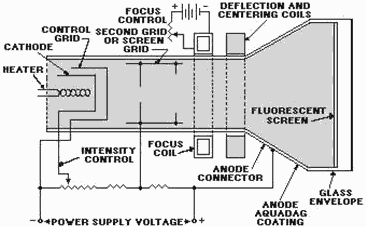
Figure 3-5. - Electromagnetic CRT construction. The electron gun in figure 3-5 is made up of a heater, cathode, control grid, second or screen grid,
focus coil, and anode (composed of a special coating). Focusing the electron beam on the face of the screen is
accomplished by the focus coil. a direct current through the windings sets up a strong magnetic field at the
center of the coil. Electrons move precisely along the axis of the tube and pass through the focusing field with
no deflection. This is because they move parallel to the magnetic field at all times. Any electron which
enters the focusing field at an angle to the axis of the tube has a force exerted on it that is perpendicular to
its direction of motion. a second force on this electron is perpendicular to the magnetic lines and is, therefore,
constantly changing in direction. These forces cause the electron to move 3-7
in a helical or corkscrew path shown in figure 3-6. With the proper velocity of the electron and
strength of the magnetic field, the electron will be caused to move at an angle which allows it to converge with
other electrons at some point on the CRT screen. Focusing is accomplished by adjusting the current flow through
the focusing coils.
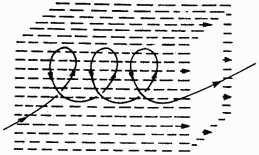
Figure 3-6. - Helical motion of electron through a uniform magnetic field. The focused electron beam is deflected by a magnetic field that is generated by current flow through a
set of deflection coils, as shown in figure 3-5. These coils are mounted around the outside surface of the neck of
the CRT. Normally, four deflection coils (N, S, E, and W) are used, as shown in figure 3-4. Two coils in series
are positioned in a manner that causes the magnetic field produced to be in a vertical plane. The other two coils,
also connected in series, are positioned so that their magnetic field is in a horizontal plane. The coils (N-S)
which produce a horizontal field are called the VERTICAL DEFLECTION Coils and the coils (E-W) which produce a
vertical field are called the HORIZONTAL DEFLECTION Coils. This may be more clearly understood if you recall that
an electron beam will be deflected at right angles to a deflecting field. The deflection coils are illustrated in
view a of figure 3-7. View B shows the N-S windings in schematic form. 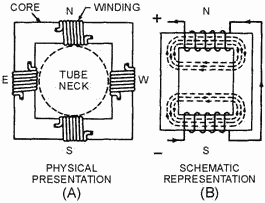
Figure 3-7. - Deflection yoke. 3-8
Electron deflection in the electromagnetic CRT is proportional to the strength of the magnetic fields.
Magnetic field strength depends on current in the coils. The sweep circuits associated with electromagnetically
deflected cathode-ray tubes must provide currents, rather than voltage, to produce the desired beam deflection. A sawtooth current is required to produce a linear trace. a deflection coil may be considered equivalent to the
circuit shown in view a of figure 3-8. Because of the inductance of the coil, a trapezoidal voltage must be
applied across the coil to produce a sawtooth of current through it. This is illustrated in view B. (Refer to
NEETS, Module 9, Introduction to Wave-Generation and Wave-Shaping Circuits, for a review of wave shaping.) 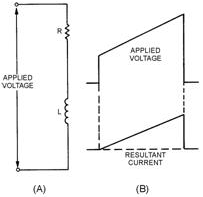
Figure 3-8. - Deflection coil equivalent circuit and waveform. Sweep Rotation Azimuth indication of the PPI requires that the range trace rotate
about the center of the screen. a very simple means of achieving sweep rotation is to cause the deflection coil to
rotate about the neck of the CRT in synchronization with the antenna motion. This method, however, has the
disadvantages of inaccuracy and maintenance complications inherent to any mechanical gear-train assembly. Most modem PPI systems employ fixed deflection coils and use special circuits to electronically rotate the
magnetic field. Figure 3-9 illustrates a method of electronically producing a rotating sweep. In view A, a range
sweep current, i, is applied to the vertical deflection coils only. The resulting magnetic field, represented by
!, lies along the axis of these coils. The resulting range trace, shown by the short straight line, is vertical
because the electron beam is deflected perpendicular to the magnetic field. In view B, range sweep currents are
applied to both sets of coils, and the resultant magnetic field takes a position between the axes of the two sets
of coils. Because of this shift of the magnetic field, the range trace is rotated 45 degrees clockwise from its
previous position. In view C, the sweep current is applied to the horizontal deflection coils only, and the range
trace lies 90 degrees clockwise from its original position. Further rotation is obtained if the polarities of the
deflection coil currents are varied in proper sequence, as illustrated in views D and E. 3-9

Figure 3-9. - Trace rotation. To synchronize sweep rotation with antenna rotation, you must convert antenna azimuth (bearing)
information into electrical signals. These signals, usually provided by synchros, control the amplitudes and
polarities of the sawtooth sweep currents applied to the deflection coils. Figure 3-10 illustrates the
waveforms of current required to produce a rotating range sweep. The amplitudes of the sawtooth sweep currents are
varied sinusoidally (like a sine wave), corresponding to the rotation of the antenna. Notice that there is a 90
degree phase difference between the amplitude variations of the horizontal and vertical waveforms. 3-10
| - |
Matter, Energy,
and Direct Current |
| - |
Alternating Current and Transformers |
| - |
Circuit Protection, Control, and Measurement |
| - |
Electrical Conductors, Wiring Techniques,
and Schematic Reading |
| - |
Generators and Motors |
| - |
Electronic Emission, Tubes, and Power Supplies |
| - |
Solid-State Devices and Power Supplies |
| - |
Amplifiers |
| - |
Wave-Generation and Wave-Shaping Circuits |
| - |
Wave Propagation, Transmission Lines, and
Antennas |
| - |
Microwave Principles |
| - |
Modulation Principles |
| - |
Introduction to Number Systems and Logic Circuits |
| - |
- Introduction to Microelectronics |
| - |
Principles of Synchros, Servos, and Gyros |
| - |
Introduction to Test Equipment |
| - |
Radio-Frequency Communications Principles |
| - |
Radar Principles |
| - |
The Technician's Handbook, Master Glossary |
| - |
Test Methods and Practices |
| - |
Introduction to Digital Computers |
| - |
Magnetic Recording |
| - |
Introduction to Fiber Optics |
| Note: Navy Electricity and Electronics Training
Series (NEETS) content is U.S. Navy property in the public domain. |
|

















